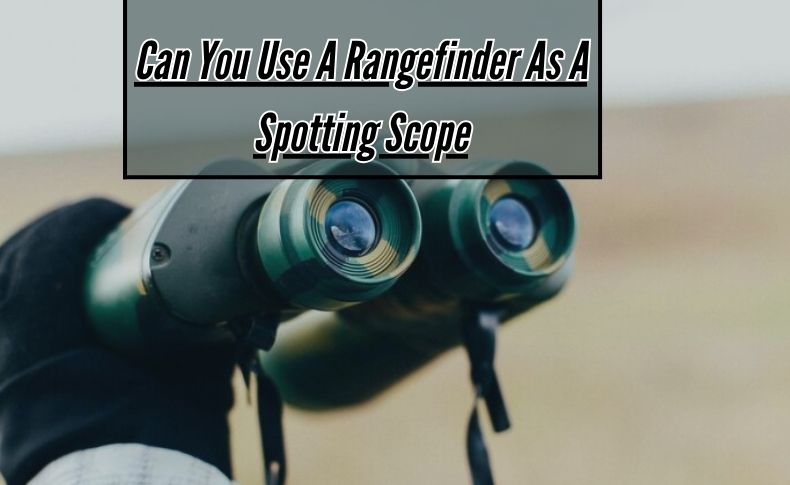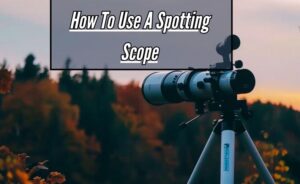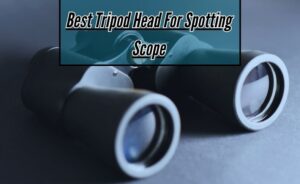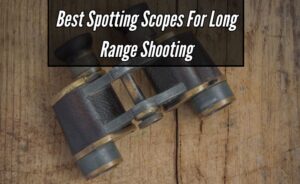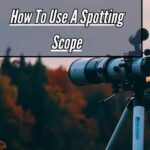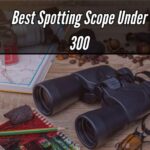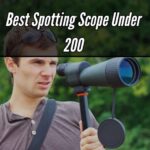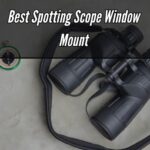The interchangeability of various tools is a topic that comes up frequently when exploring the world of optics. One of these concerns is whether or not a rangefinder can double as a spotting scope. Rangefinders are primarily made for measuring distance, but spotting scopes are made for crisp, in-depth observation of far-off objects.
Can You Use A Rangefinder As A Spotting Scope? No, you cannot use a rangefinder as a spotting scope. Both devices have optical parts, but their main uses are different. A spotting scope is used to magnify and see faraway things with greater clarity and detail while a rangefinder is made to measure distance precisely.
These two tools have different functions. In this discussion, we’ll examine how rangefinders and spotting scopes work, including whether a rangefinder can actually serve as a spotting scope and any potential drawbacks that can result.
Understanding Rangefinders and Spotting Scopes
Rangefinders and spotting scopes are essential tools for outdoor enthusiasts, wildlife observers, hunters, and target shooters, providing accurate measurements and magnification capabilities that greatly enhance one’s outdoor experience. These devices serve distinct purposes but share common features that make them indispensable for various activities.
Rangefinders:
Precision Measurement at a Distance Rangefinders are compact optical devices designed to measure the distance between the user and a target object accurately. They employ advanced technology, such as lasers or GPS, to calculate distances with remarkable precision.
Rangefinders find applications in golf, hunting, surveying, and even photography, allowing users to gauge distances without the need for physical markers. They are particularly valuable in hunting, enabling hunters to assess target range for precise shots, promoting ethical and humane hunting practices.
Spotting Scopes:
Bringing the Distant World Closer Spotting scopes are high-powered telescopes designed for terrestrial observation. They provide detailed magnification of distant objects, making them ideal for birdwatching, nature observation, surveillance, and target spotting.
Unlike binoculars, spotting scopes offer higher magnification, typically ranging from 20x to 60x or even more, and can be mounted on tripods for stable viewing. Their excellent light-gathering capabilities and larger objective lenses result in sharper images, even in challenging lighting conditions.
Key Features and Considerations
Both rangefinders and spotting scopes share some key features and considerations that users should be aware of before making a purchase. Optics quality is paramount, as premium glass and coatings enhance image clarity, color fidelity, and low-light performance.
Weather resistance is another vital factor, especially for outdoor enthusiasts who may encounter rain, snow, or dust. Additionally, a compact and lightweight design is desirable for portability.
Choosing the Right Device
Selecting the appropriate rangefinder or spotting scope depends on the intended use. For rangefinders, features like maximum range, ease of use, and additional functions like angle compensation should be evaluated.
In the case of spotting scopes, considerations include magnification range, objective lens diameter, and the field of view. Birdwatchers might prioritize a wider field of view, while target shooters might focus on higher magnification levels.
Applications and Ethics
Rangefinders and spotting scopes serve not only practical purposes but also ethical ones. Hunters, for instance, benefit from rangefinders in ensuring humane and accurate shots, minimizing the risk of wounding animals.
Spotting scopes enable wildlife enthusiasts to observe animals from a distance without causing disturbance, promoting responsible wildlife interaction. It’s important for users of both devices to adhere to ethical guidelines that prioritize safety, conservation, and respectful engagement with the environment.
Key Differences Between Rangefinders and Spotting Scopes
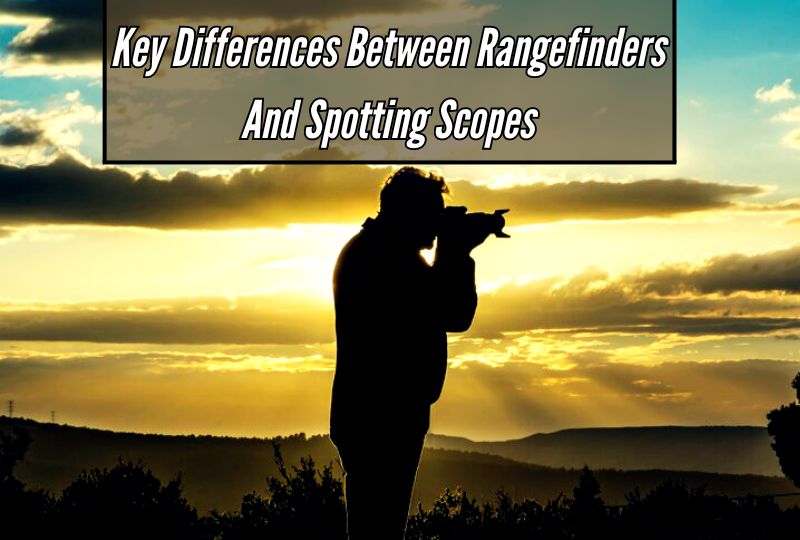
Rangefinders and spotting scopes are both essential tools in various outdoor activities, such as hunting, birdwatching, and target shooting. While they share some similarities in their applications, they differ significantly in terms of functionality and purpose.
Understanding the distinctions between these two devices can help enthusiasts make informed decisions about which one suits their needs best.
Functionality and Purpose:
Rangefinders primarily serve the purpose of measuring the distance between the user and a target object. They utilize laser technology to calculate the precise distance, which proves invaluable in hunting scenarios or golfing, where accuracy in distance estimation is crucial for making precise shots.
On the other hand, spotting scopes are designed to provide magnified views of distant objects, making them indispensable for activities like birdwatching, nature observation, and surveillance.
Magnification and Optics:
Spotting scopes excel in providing high magnification levels, often ranging from 20x to 60x or even higher. This allows users to observe intricate details of distant subjects.
Rangefinders, however, prioritize accurate distance measurement over magnification, with their optics designed to enhance accuracy rather than zoom capabilities. The magnification in rangefinders is usually limited, ranging from 4x to 8x, making them less suitable for detailed observations.
Target Acquisition:
Rangefinders are primarily used to locate and measure the distance to a specific target. They often feature advanced technologies like angle compensation, which takes into account the user’s angle relative to the target for more accurate distance calculations.
Spotting scopes, on the other hand, are focused on providing clear visuals of distant subjects, aiding in identifying details like bird species or game animals’ behaviors.
Compactness and Portability:
In terms of portability, rangefinders generally have an advantage due to their compact and lightweight design. They can be easily carried in a pocket or attached to a belt.
Spotting scopes, being larger and bulkier due to their high-powered optics, often require a tripod for stable viewing. This makes spotting telescopes more suitable for stationary observations rather than quick, on-the-go distance measurements.
Versatility and Application:
Rangefinders are highly versatile tools that find use in activities where accuracy in distance measurement is paramount. They’re favored by hunters, golfers, and archers for their ability to aid in precise targeting.
Spotting telescopes, on the other hand, excel in scenarios where detailed visual observation is essential. Birdwatchers, astronomers, and naturalists rely on spotting scopes to appreciate intricate features of distant subjects without disturbing them.
Unlocking Versatility: How to Maximize Your Rangefinder’s Potential as a Spotting Scope
Do you want to improve your outdoor experiences? Uncover the concealed utility of your rangefinder as a spotting scope.
This tutorial will cover a variety of easy-to-use methods to make the most of its versatility, from figuring out optical mechanics to perfecting target acquisition. Using your reliable rangefinder, discover a whole new realm of discovery.
The Multifaceted Utility of Rangefinders
Despite being disregarded for their singular use, rangefinders are just as versatile as spotting scopes. In addition to serving as distance measurers, they have the ability to improve outdoor experiences by allowing for more detailed imaging and astute observation.
Deciphering Optical Mechanisms for Enhanced Viewing
Examining your rangefinder’s complex optical mechanisms is essential to making the most of it as a spotting scope. Users can refine their observations and capture far-off objects with amazing clarity and detail by knowing how lenses, prisms, and focal points interact.
Navigating Diverse Terrain with Precision
To get the most out of your rangefinder in spotting scope mode, it must be able to adjust to different types of terrain and weather.
Users may see details even in difficult terrain by adjusting parameters like focus, brightness, and magnification, which enable excellent performance in a variety of environments, from dense forests to wide-open plains.
Fine-Tuning Techniques for Seamless Target Acquisition
When it comes to outdoor pursuits like hunting, animal observation, or spying, efficiency in target acquisition is crucial.
Users may quickly and accurately identify targets by mastering methods including panning, scanning, and using reticles to switch between range and spotting modes.
Elevating Outdoor Adventures Through Enhanced Observation
Enhancing observation and exploration during outdoor expeditions can be made possible by using a rangefinder as a spotting scope.
Users can fully immerse themselves in the natural world, discovering hidden gems and developing stronger connections with their surroundings, by honing their observational skills and paying attention to tiny indications in the surroundings.
Limitations of Using a Rangefinder as a Spotting Scope
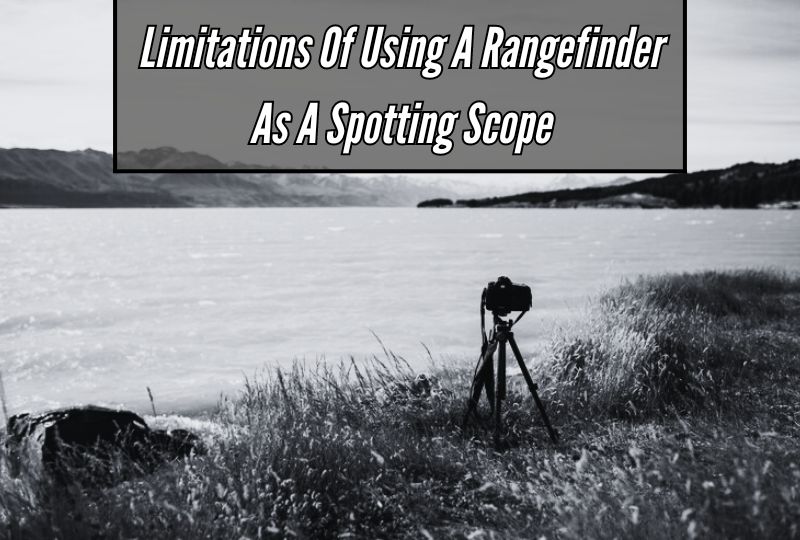
Rangefinders have proven their worth in various outdoor activities such as hunting, golfing, and wildlife observation due to their ability to accurately measure distances.
However, while they share some similarities with spotting scopes, it’s important to recognize that using a rangefinder as a spotting scope comes with several significant limitations that can impact overall performance and user experience.
Limited Magnification and Field of View:
One of the primary limitations of using a rangefinder as a spotting scope is its limited magnification and field of view. Spotting scopes are designed to offer higher amplification levels, allowing users to observe distant objects in greater detail.
Rangefinders, on the other hand, are optimized for measuring distances accurately rather than providing a wide and clear view of the target. Attempting to use a ranging tool to observe distant subjects could lead to frustration due to the lack of magnification and a restricted field of view.
Image Quality and Clarity:
Spotting scopes are crafted with advanced optics that prioritize image quality and clarity. They often incorporate features like multi-coated lenses and high-quality prisms to deliver sharp and vibrant images even under challenging lighting conditions.
Rangefinders, while they do provide clear distance measurements, may not offer the same level of optical performance as dedicated spotting scopes. As a result, using a ranging tool for extended observation periods might result in subpar image quality, hampering the overall viewing experience.
Lack of Ergonomics for Prolonged Use:
Spotting scopes are designed with ergonomics in mind, allowing users to comfortably observe subjects for extended periods. They often feature adjustable eyepieces, rotating bodies, and adaptable mounting systems to enhance user comfort and convenience.
Rangefinders, on the other hand, might lack these ergonomic features. Prolonged use of a ranging tool as a spotting telescope could lead to discomfort and strain, particularly when trying to maintain a steady view of distant objects.
Limited Adaptability for Digiscoping:
Digiscoping, the practice of attaching a camera or smartphone to a spotting scope to capture distant images, has gained popularity among outdoor enthusiasts and photographers. Spotting scopes are frequently designed with the necessary attachments and adapters to facilitate digiscoping.
Rangefinders, however, might not offer the same level of adaptability, making it challenging to achieve high-quality digiscoping results. This limitation could restrict the creative possibilities for capturing memorable moments in the field.
Durability and Weather Resistance:
Spotting scopes are often built to withstand various environmental conditions, including rain, dust, and extreme temperatures. They feature rugged construction and are equipped with protective coatings to ensure durability and reliable performance in the field.
Rangefinders, though durable in their own right, might not possess the same level of weather resistance as spotting telescopes. Using a rangefinder as a makeshift spotting scope could potentially expose it to elements that it wasn’t specifically designed to endure, thus compromising its longevity.
Advantages of Using a Rangefinder as a Spotting Scope
Rangefinders, primarily designed for distance measurement, have found a new application as spotting scopes, providing a multitude of advantages. This innovative utilization of rangefinders offers distinct benefits that enhance the overall experience of observing distant subjects in the wild.
Compact Portability:
One of the most notable advantages of using a rangefinder as a spotting scope is its compact size and lightweight nature. Traditional spotting scopes can be bulky and cumbersome to carry, especially during extended outdoor activities.
Rangefinders, on the other hand, are designed to be extremely portable, fitting easily into pockets or small bags. This feature makes them an ideal choice for individuals who prefer to travel light while still having powerful optics at their disposal.
Versatile Functionality:
Rangefinders equipped with spotting scope capabilities offer versatile functionality. Not only can they accurately measure distances, but they can also provide clear magnification of distant objects, allowing users to closely observe wildlife, landscape details, or even celestial bodies.
This dual-purpose aspect eliminates the need to carry separate devices, streamlining the gear and minimizing the load.
Quick Target Acquisition:
Rangefinders excel at rapid target acquisition due to their laser-based distance measurement technology. When used as a spotting scope, this technology can be leveraged to quickly lock onto a subject, providing a clear and magnified view almost instantly.
This advantage is particularly crucial in scenarios where the subject is in motion or when capturing fleeting moments in nature, such as birds in flight.
Reduced Cost:
Acquiring a dedicated spotting scope can often be a significant financial investment. Using a rangefinder as a spotting scope presents a more cost-effective option, especially for individuals who already own a rangefinder. This allows users to enjoy high-quality optics for observing distant subjects without the need for an additional substantial expenditure.
Simplicity and Convenience:
Rangefinders turned into spotting scopes offer a simplified and convenient experience. Their user-friendly interfaces, often designed with intuitive controls, ensure that even those unfamiliar with complex optical equipment can quickly adapt and start using them effectively.
This simplicity is advantageous for beginners or those who prefer a hassle-free experience without compromising on quality.
Making Informed Decisions: Rangefinder vs. Spotting Scope for Observation
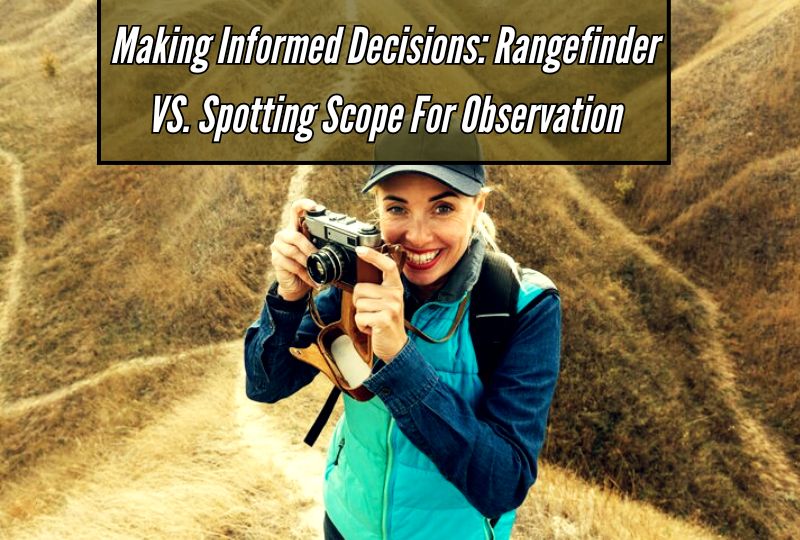
When it comes to outdoor activities such as hunting, birdwatching, or nature photography, having the right optical equipment can greatly enhance the experience. Two commonly used tools for observation are rangefinders and spotting scopes, each offering distinct advantages that cater to specific needs.
Making an informed decision between the two involves understanding their features, applications, and limitations.
The Power of Precision:
Rangefinders are specialized devices designed to measure the distance between the user and a target. They utilize advanced laser technology to emit a laser beam, which reflects off the target and returns to the rangefinder, allowing it to calculate the distance with impressive accuracy.
Ranging tools are particularly valuable for activities where distance estimation is critical, such as hunting and golfing. They offer a quick and efficient way to determine the exact distance to a target, aiding in accurate aiming or club selection.
Capturing Every Detail:
Spotting scopes, on the other hand, are high-powered portable telescopes primarily designed for observing distant objects with remarkable clarity. These scopes deliver enhanced amplification and superior light-gathering capabilities, making them indispensable tools for birdwatchers, astronomers, and wildlife enthusiasts.
The optical quality of spotting telescopes often surpasses that of rangefinders, allowing users to enjoy intricate details and vibrant colors in their subjects. Their versatility in both terrestrial and celestial observation adds to their allure.
Understanding Applications and Trade-offs
Choosing between a rangefinder and a spotting scope largely depends on the intended use. Rangefinders excel in scenarios where precise distance measurements are paramount, such as hunting, archery, and target shooting.
However, they do not offer the same level of amplification as spotting scopes, limiting their effectiveness in tasks requiring detailed observation. Spotting telescopes, with their zoom capabilities and adaptable eyepieces, are better suited for birdwatching, nature photography, and activities where observing fine details is essential.
Cost Considerations and Budget
Budget plays a significant role in the decision-making process. Rangefinders are generally more affordable than high-quality spotting scopes due to the complexity of optics and amplification capabilities involved in the latter.
While rangefinders can provide accurate distance measurements without breaking the bank, spotting scopes with their impressive optics can be a more substantial investment. It’s essential to align the chosen equipment with both intended use and available budget.
Conclusion
In conclusion, even if a rangefinder and a spotting scope have different functions, there is a chance for limited cross-functionality. While a rangefinder can offer basic magnification, it lacks the precise optics and features of a specialist spotting telescope for tasks like birding or long-range target spotting.
It’s crucial to understand that while a ranging tool could provide a temporary fix in some circumstances, purchasing a quality spotting telescope is still the best option for making precise and clear observations at a distance.
Frequently Asked Questions (Can You Use A Rangefinder As A Spotting Scope)
Is there a spotting scope with rangefinder?
There are spotting scopes with built-in rangefinders on the market, providing greater capability for hunters, birdwatchers, outdoor lovers, and even professional photographers. These spotting telescopes with rangefinders combine a spotting scope’s magnification capabilities with a rangefinder’s ability to detect distance. For sports like hunting or target shooting that need for accurate distance measurement, this combination is very helpful.
In order to make precise shots or observations, users can use the ranging tool component to estimate the distance between themselves and the target properly. Convenience is a significant benefit of a spotting scope with a rangefinder. People can profit from both tools in a single unit rather than lugging two separate ones. However, it’s crucial to keep in mind that these integrated gadgets can be more expensive and complicated than standalone spotting telescopes or distance finders.
Do they make a rifle scope with a rangefinder?
Yes, manufacturers make rifle scopes with built-in rangefinders to meet the needs of shooters and hunters who need precise measures of distance to make accurate shots. These rifle scopes with ranging tools are made to give shooters real-time information on the distance to their target, enabling them to alter their shots and account for bullet drop over various ranges.
When rangefinder technology is included into rifle scopes, shooting accuracy can be considerably increased, especially when quick adjustments are needed to account for shifting environmental circumstances. To further improve their functionality, rifle scopes with distance finders frequently come equipped with features like illuminated reticles, ballistics information, and angle compensation. It’s crucial to take into account the extra weight, complexity, and expense of these coupled devices
What is the disadvantage of laser rangefinder?
For precisely measuring distances, laser rangefinders provide a number of benefits, but they also have certain drawbacks. They are susceptible to specific environmental conditions, which is one of the main drawbacks. Using the time it takes for the laser beam to travel, laser ranging tools create a laser beam that bounces off the target and returns to the instrument, enabling it to determine the distance.
Inaccurate readings or even the inability to measure distances at all can result from airborne contaminants such fog, rain, snow, and dust particles interfering with the laser beam. Despite these drawbacks, many contemporary laser rangefinders integrate cutting-edge technologies to address these problems. While other models offer continuous distance measurements for moving targets, certain models offer target mode settings to increase accuracy in challenging circumstances. These drawbacks are diminishing in importance as technology develops, and laser rangefinders are becoming more and more trustworthy tools for measuring distance.
How does the cost of a rangefinder with spotting capabilities compare to a standalone spotting scope?
The dual functionality of a rangefinder with spotting capabilities usually makes it more expensive than a standalone spotting telescope. While spotting scopes offer precise magnification for monitoring far-off objects, rangefinders calculate distances to help with target acquisition. When these characteristics are combined into one gadget, the cost of production goes up, which is reflected in the final price.
Due to their exclusive concentration on amplification, standalone spotting scopes are typically less expensive. A rangefinder with spotting capabilities is worth the cost if you value both precise observation and distance measurement. Your decision will rely on your particular circumstances. If amplification is all that is needed, though, a single spotting telescope can be a more affordable option.
Can a rangefinder double as a spotting scope for hunting purposes?
A rangefinder can’t completely replace a spotting scope for hunting, even if its primary purpose is distance measurement. For careful target observation, ranging tools don’t provide the fine clarity and magnification required. When it comes to seeing animals during a hunt, spotting scopes with their excellent optics provide clear, up-close views that are vital.
It is advised to utilize a rangefinder in conjunction with a specialized spotting telescope for a thorough hunting experience, even if distance finders can be useful tools for measuring distances. Optimizing your odds of success in the field by combining both techniques ensures precise ranging and in-depth observation.
How far can a rangefinder see?
Measure the distance between the observer and a target using a rangefinder, which is a useful tool. Depending on the kind and model, a rangefinder has a specific viewing area. Depending on the model and factors like the weather and visibility, laser ranging tools, for instance, are relatively common and can precisely estimate distances up to several kilometers.
In order to calculate the distance, they employ laser pulses to gauge how long it takes the beam to bounce back. A rangefinder’s range capabilities may differ depending on whether it is optical or ultrasonic. To acquire a precise sense of the ranging tool’s greatest capability, it’s crucial to consult the manufacturer’s specs for that particular model.

